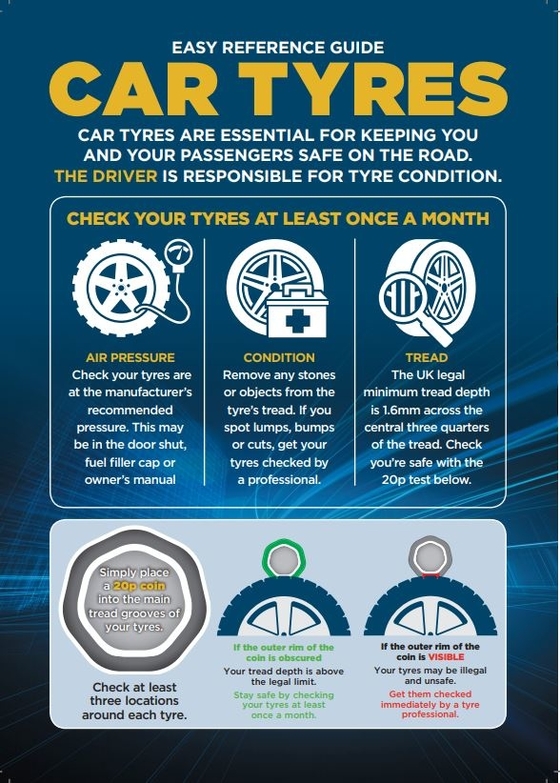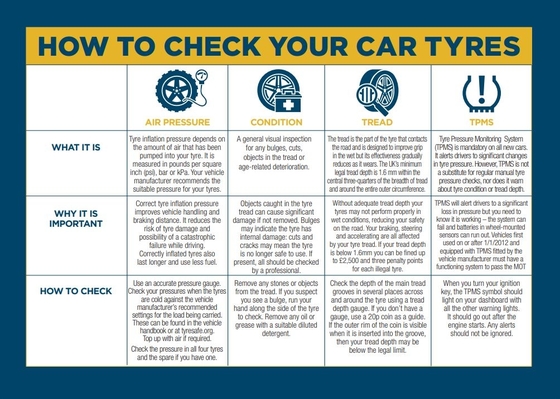
Correct tyre care and maintenance are critical for your safety, no matter what type of vehicle you are driving. Tyres are the only parts of the car which are in contact with the road and correct tyre safety is essential for acceleration, braking, steering and cornering.

Tyre Safety – Check Your Tyres and check your knowledge!
Q. How often should my tyres be checked?
A. Tyres should be inspected at least once a month and before any long journey. Checks should include checking the air pressure, overall condition and tread depth. And don’t forget to check the spare or the compressor and sealant if no spare was fitted!
Q. What should I do when checking my tyres?
A. Tread depths should be checked to ensure they meet the legal minimum regulations. Pressures should be checked in line with the vehicle manufacturers’ recommended settings. Take care to increase the pressure if the vehicle is heavily loaded as shown in the car makers recommendations. The tyres should also be given a thorough visual inspection to look for any cuts, lumps or bulges. Also look for any objects embedded in the tread which should be removed.
Q. What is the minimum legal tread depth?
A. Current NI law requires car, van and LCV drivers to have at least 1.6mm of tread across the central three-quarters of the tyre, around its entire circumference. For trucks (vehicles exceeding 3.5 tonnes g.v.w), current tread depth legislation requires that they must have a minimum of 1mm of tread in a continuous band throughout the central three-quarters of the tread width and over the whole circumference of the tyre. The same regulation applies to regrooved tyres. Meanwhile, for motorcycles over 50cc it is 1mm across ¾ of the width of the tread pattern and with visible tread on the remaining ¼. For motorcycles up to 50cc the law requires that all the grooves of the original tread pattern must be clearly visible.
Q. What are the fines for driving with illegal tyres?
A. Drivers who fail to comply with the regulations face a fine of up to £2,500 and three penalty points.
Q. Why is tread depth important?
A. Adequate tread depth is essential for good grip on wet roads as the tread pattern helps to remove water from between the tyre and the road surface. Drivers with insufficient tread depth face longer stopping distances, reduced grip and an increased risk of aquaplaning.
Q. Why is correct tyre pressure important?
A. To stay safe on the road your car needs to have the correct tyre pressure. If the tyres are under or over inflated then handling and grip will worsen, potentially causing irregular or unpredictable car behaviour. Tyres with insufficient air are also more likely to suffer from a sudden rapid deflation and will suffer premature wear on the outside edges of the tyre.The wheel rim and tyre will be more susceptible to impact damage. Over-inflation results in less comfortable ride, a reduced area of contact with the road giving less grip in the day and accelerated wear on the tread centre. The benefits of a properly inflated tyre, include reduced running costs and longer tyre life.
Q. How many miles can I get from my set of tyres?
A. Tyre life is very dependent on the way that they are used. A set of tyres well maintained and used exclusively on motorways can return a much higher mileage against tyres badly maintained and ill-treated in a city centre and urban environment.
Q. Should I fit four new tyres at a time?
A. It’s better to fit all four tyres at the same time but if that is not possible then fitting two tyres at a time, and as a pair to get the best handling and grip on each axle, is the next best option. As a last resort, then a single tyre can be replaced. In all circumstances, seek the advice of an expert tyre retailer before replacing any tyres.
Q. Which is the best axle to place new tyres on?
A. New tyres on the rear axle provide better driver control on wet roads. This is because tyres with deeper tread are better at displacing water and give better grip. If the new tyres are fitted at the front the car, then it is more likely to oversteer when grip is lost in wet weather, which is much harder to control than understeer. Oversteer is when the rear of the car slides sideways, and understeer is when the front of the car slides.
More information on vehicle maintenance is available on nidirect and visit TyreSafe for more on tyre safety.
Follow us on Facebook, X and Instagram for daily road safety advice and Highway Code Rules.